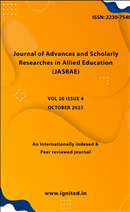Impact of Civil Society and Government Organisations on Women Trafficking
Keywords:
women trafficking, civil society, government organizations, South Asia, commercial sexual exploitation, forced bonded labour, intra-regional trafficking, Middle East, push and pull factors, sexual exploitationAbstract
The aim of this study is to the Trafficking of women and children are not limited to territories ofa country. It extends well beyond the limits of any single country. Over time, various countries in SouthAsia have emerged as the most important nodal centres for trafficking sources, destinations, and transitsites. Commercial sexual exploitation and forced bonded labour are only two of the many objectives forwhich trafficking has become a major source, destination and transit point in India. The bulk of traffickingvictims are victims of intra-regional trafficking, although persons from countries like Nepal andBangladesh are also migrating across borders to be trafficked. The Middle East is also a destination for alarge number of trafficked Indian women and children who are subjected to forced labour bonds andcommercial sex exploitation. Underdeveloped places have a worse situation because of the push andpull factors that lead to trafficking and the balance between the mechanisms of demand and supply.Trafficking women and children from India's north-eastern states, as well as all of its neighbouringnations, despite several legal and constitutional remedies is still an ongoing problem. Women andchildren in this region have been particularly vulnerable to sexual exploitation as a result of extremistactivity, ethnic tensions, and disputes between various regional groups. The federal, state, and localgovernments, as well as non-governmental organisations (NGOs) working in this field, should take acomprehensive approach to combating human trafficking because of the problem's multifaceted nature.The condition of human trafficking around the world is being exacerbated by both Push and Pull causes.The most vulnerable people in society are those who are marginalized, backward, and socially andeconomically marginalized. Even more distressingly, among these trafficking victims, the female kidsuffers the most because she is regarded a nuisance or a burden rather than an asset by the family.References
Kinnu, Gunjan, (2006). From bondage to freedom, India, National Human Rights Commission, New Delhi.Articles and News items:
Kumar Bag, Dr. Khokan, Basu Roy, Piyal, March 2012, “Changing face of women exploitation”, International journal of Social Science Tomorrow
Kumar Chhetri et al.; Women Trafficking in Darjeeling and Dooars Sch. J. Arts. Humanit. Soc. Sci., October 2015; 3(7A)
Kumar, A.S,2005,” Child Labour in home based sector”, Sonali Publications, New Delhi
Kunze, E. I. (2010): Sex Trafficking via the Internet: How International Agreements address the problem and fail to go far enough. Journal of High Technology Law, 241-289
Lutya.T.M and Lanier.M.(2012):An Integrated Theoretical framework to describe Human Trafficking of young Women and girls for Involuntary Prostitution. In Jay Maddock; Public Health-Social and Behavioural Health www.intechopen.com pp555-570
Magar, V., 2012. Rescue and Rehabilitation: A Critical Analysis of Sex Workers‟ Antitrafficking Response in India, Signs, 37(3), 619-644.
Mishra, Veerendra, 2013,” Human Trafficking: The Stakeholders Perspective”, Sage Publications India Pvt Ltd
Mukherjee, K.K and Deepa Das, 1996, “Prostitution in the Six Metropolitan Cities of India, New Delhi: Central Social Welfare Board, Pp 34-35
Mukherjee, K.K and Deepa Das, 1996, “Prostitution in the Six Metropolitan Cities of India, Central Social Welfare Board, New Delhi
Nair, P.M. and Sankar Sen. 2005. “Trafficking in Women and Children in India”. Hyderabad, India: Orient Longman.
Roy S, Chaman C. Human rights and trafficking in women and children in India. J His Arch & Anthropol Sci. 2017;1(5):162‒170. 8. Human Rights Watch. Background briefing: International trafficking of Women HRW, USA; 2000.
Roy,Sanjoy, Chaman Chandan, 2017,”Human rights and trafficking in women and children in India”, Department of social work, University of Delhi








